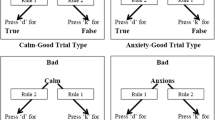Abstract
The effects of two intimacy manipulations, 80% eye contact (EC) and combined lean, touch, 50% eye contact (LT), were examined in a bogus waiting period involving a male confederate-male subject pairing. Hypothesized arousal increase was found only for the LT manipulation when it occurred later, rather than earlier, in the waiting period. Associated with that increased arousal were weak tendencies for increased eye contact and talking. These results offered limited support for the arousal model of interpersonal intimacy (Patterson, 1976). However, it also appeared that the directing effect of the specific social context qualified the impact and meaning of the confederate's high intimacy.
Similar content being viewed by others
References
Argyle, M., & Dean, J. Eye-contact, distance, and affiliation.Sociometry, 1965,28, 289–304.
Bohlin, G. Delayed habituation of the electrodermal orienting response as a function of increased level of arousal.Psychophysiology, 1976,13, 345–351.
Breed, G. The effect of intimacy: Reciprocity or retreat?British Journal of Social and Clinical Psychology, 1972,11, 135–142.
Chapman, A. J. Eye contact, physical proximity and laughter: A re-examination of the equilibrium model of social intimacy.Social Behavior and Personality, 1975,3, 143–155.
Ellsworth, P. C., & Ludwig, L. M. Visual behavior in social interaction.Journal of Communication, 1972,4, 375–403.
Foot, H. C., Chapman, A. J., & Smith, J. R. Friendship and social responsiveness in boys and girls.Journal of Personality and Social Psychology, 1977,35, 401–411.
Foot, H. C., Smith, J. R., & Chapman, A. J. Individual differences in children's social responsiveness in humour situations. In A. J. Chapman & H. C. Foot (Eds.)It's a funny thing, humour. London: Pergamon, 1977.
Jourard, S. M., & Friedman, R. Experimenter-subject “distance” and self-disclosure.Journal of Personality and Social Psychology, 1970,15, 278–282.
Katkin, E. S. Relationship between manifest anxiety and two indices of autonomic response to stress.Journal of Personality and Social Psychology, 1965,2, 324–333.
Kilpatrick, D. G. Differential responsiveness of two electrodermal indices to psychological stress and performance of a complex cognitive task.Psychophysiology, 1972,9, 218–226.
Montagu, J. D., & Coles, E. M. Mechanism and measurement of the galvanic skin response.Psychological Bulletin, 1966,65, 261–279.
Patterson, M. L. Compensation in nonverbal immediacy behaviors: A review.Sociometry, 1973,36, 237–252.
Patterson, M. L. An arousal model of interpersonal intimacy.Psychological Review, 1976,83, 235–245.
Patterson, M. L. Tape recorded cuing for time sampled observations of nonverbal behavior,Environmental Psychology and Nonverbal Behavior, 1977,2, 26–29.
Patterson, M. L. The role of space in social interaction. In A. Siegman & S. Feldstein (Eds.).Nonverbal behavior and communication. Hillsdale, N. J.: Lawrence Erlbaum Associates, 1978. (a)
Patterson, M. L. Arousal change and cognitive labeling: Pursuing the mediators of intimacy exchange.Environmental Psychology and Nonverbal Behavior, 1978,3, 17–22. (b)
Schachter, S., & Singer, J. E. Cognitive, social and physiological determinants of emotional state.Psychological Review, 1962,69, 379–399.
Storms, M. D., & Thomas, G. C. Reactions to physical closeness.Journal of Personality and Social Psychology, 1977,35, 412–418.
Whitcher, S. J., & Fisher, J. D. Multi-dimensional reaction to therapeutic touch in a hospital setting.Journal of Personality and Social Personality, 1979,37, 87–96.
Author information
Authors and Affiliations
Additional information
The authors thank Larry Halligan and Joan Naylor for their assistance in conducting this experiment and also Bill Ickes for his constructive comments.
This project was completed under National Institute of Health grant, USPH RO1 MH 32386 01 awarded to the first author.
Rights and permissions
About this article
Cite this article
Patterson, M.L., Jordan, A., Hogan, M.B. et al. Effects of nonverbal intimacy on arousal and behavioral adjustment. J Nonverbal Behav 5, 184–198 (1981). https://doi.org/10.1007/BF00986135
Issue Date:
DOI: https://doi.org/10.1007/BF00986135



